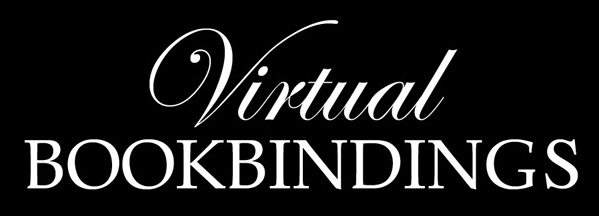

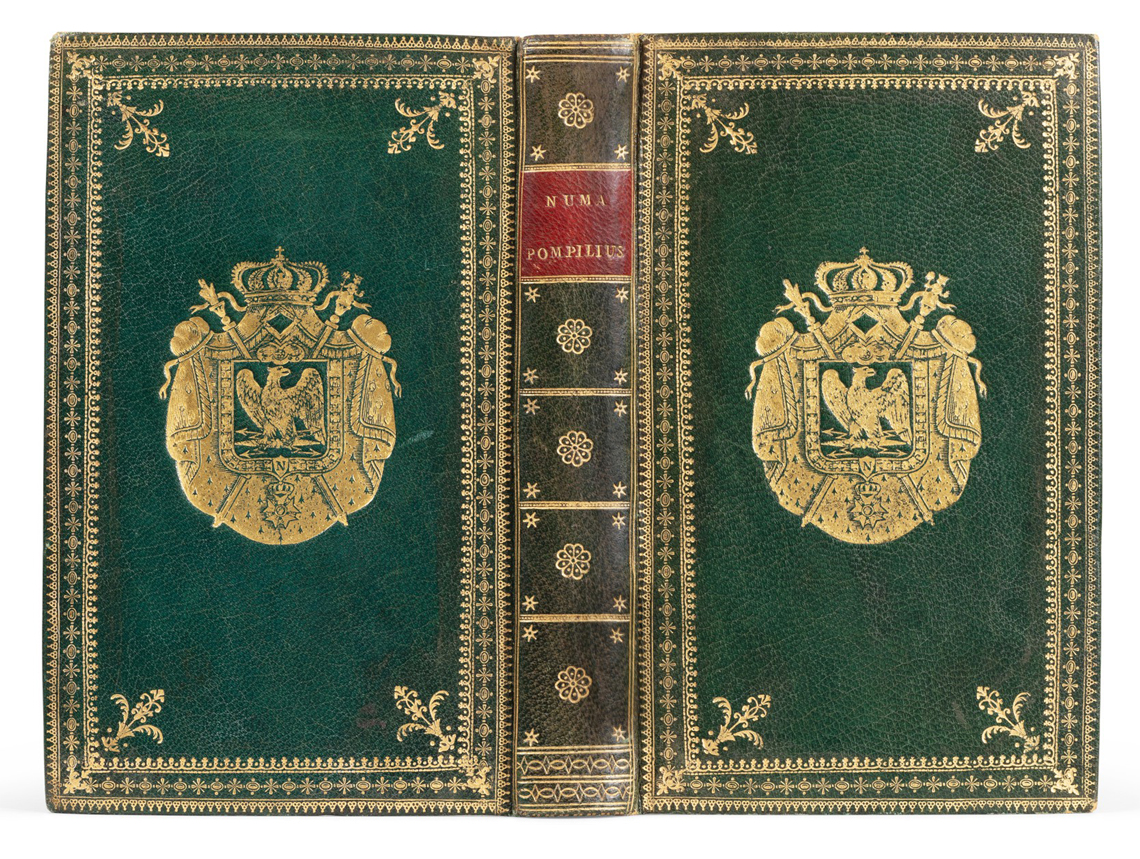
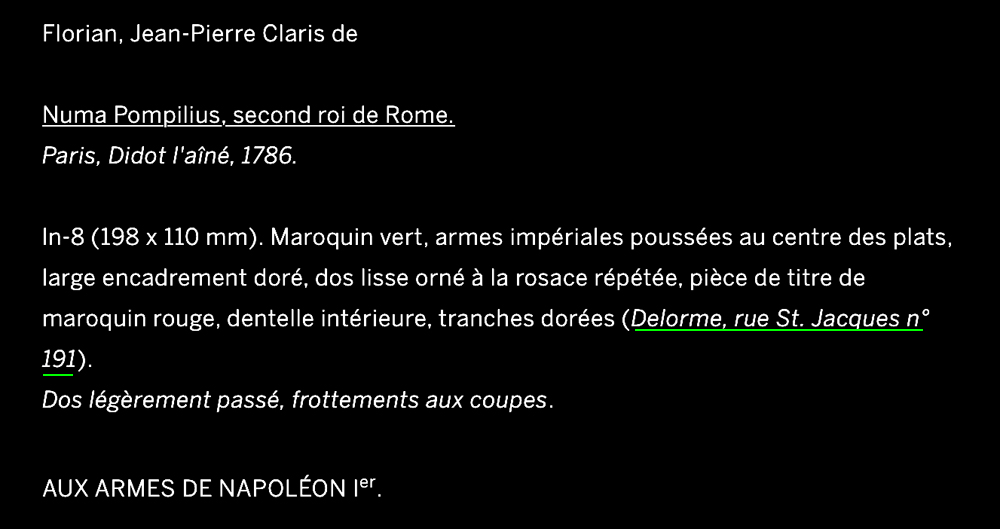
|
The binding shown above is found in a relatively recent Sotheby's online auction catalogue
Livres et Manuscrits : de Cervantès à Houellebecq
25 June 2021
this was item 28 in this auction and according to the auction information this binding had a Delorme ticket inside
(Delorme, rue St. Jacques n° 191) although Sotheby's do not show it.This is for me a great discovery in as much as the imprints found on this binding confirm/authenticate those found other bindings from a similar period that we have studied previously. First however, we need to tackle the question of the arms of Napoleon that have been stamped in the center of the boards. It may be that these particular arms did not exist before 1804 which is the year that he Napoleon Bonaparte became Emperor of the French. According to Leon Gruel, Pierre Delorme started his career as a professional bookbinder on August 29th 1763. if we imagine that he was perhaps about 25 years old at this time and was binding books up to at least 1791 (as far as we know), when he could have been about 53, so it seems doubtful but not impossible that he was still binding books in 1804. Anyway even if Delorme was working in 1804 I doubt very much that his bindings would look anything like the ones he made in 1786. So the arms of Napoleon were probably applied at a much later date. It would be nice to know if Napoleon actually owned and read this book that may have been very much to his taste. |
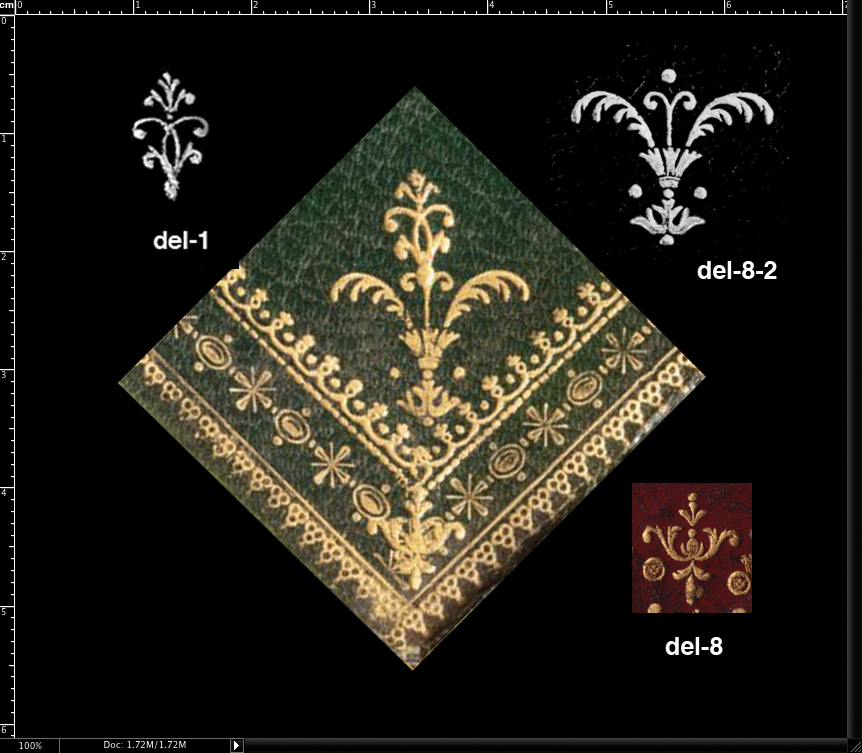
| In Comparative Diagram 1, we can show that the imprints found on this 1786 Delorme binding appear to be the same as those that we have catalogued previously. Confirming that this is indeed a binding decorated by Derome. Within the Sotheby's information about this item they give the dimensions of the binding as 198 x 110 mm. I am not convinced that is the exact measurement, searching the internet for more examples of this book reveals copies that are only 19 cm tall or less. The imprints extracted from this binding reproduced to that size, appear to be slightly larger than the Delorme originals. |

| In Comparative Diagram 2, we look at an important Delorme roulette (del-r-xox), that he employed on many bindings in the third quarter of the 18th century. It has been detailed on another page (click here to see this) and can be recognized easily under magnification by a particular defect indicated by the arrows and repeats every 12th unit of the same shape. When I was looking for a catalogue name for this roulette, I wanted to find one that would make it easy to remember and came up with xox but in retrospect it would have been better as oxox or xoxo, having said that, I know now that you, the reader will never forget the name of this important Delorme roulette with its particular flaw. I recently came across a binding that appeared to be decorated with the del-r-xox, you can find it in the online collections of the Metropolitan Museum of Art (click here to see it) this is a 1792 Almanach Royal, the roulette looks identical to that of Delorme as does the framing roulette found on this binding. You can find a high resolution copy of this binding on the Wiki Commons site (click here to see it). What we discover is that the outer border or framing roulette is a sort of variation of the Louvre or wreath border as Barber has called it. We can see a 1763 Delorme binding with this same sort of border and this would have been some of Delorme's earliest post Dubuisson work (see these bindings) and that he or Dubussion used the same roulette on a 1760 livre rouge (see this) now this is starting to sound complicated so I have made Comparative Diagram 3. |
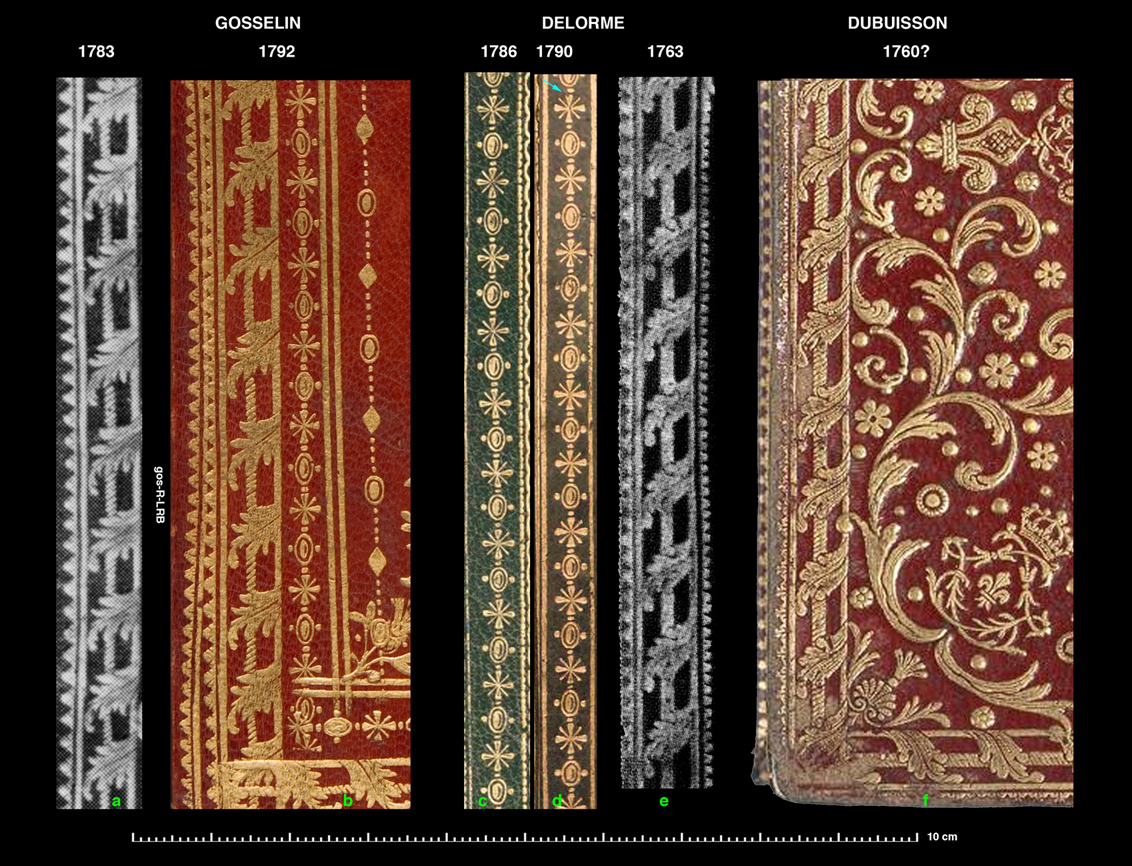
| In Comparative Diagram 3, we see Gosselin roulettes and in the middle Delorme roulettes and a possibly Dubuisson or Delorme c. 1760 binding with the same wreath border. The 1792 Almanach Royal mentioned above is shown marked with the green 'b' we can see the xox roulette compared with the Delorme examples, more important is the wreath border roulette this same roulette is found on Gosselin bindings such as the 1783 example (see this Gosselin binding) and the leaf rail border on that page I call this wreath boarder variant a leaf rail border. The interesting point of this diversion besides identifying the binder of this Almanach is in the observing of the very close correspondence of Gosselin's tools and binding design to that of Delorme in the same period, and it may be that from 1792 onward it was Gosselin who took over the job of decorating the Almanachs, imagining then that Delorme had retired from this work |
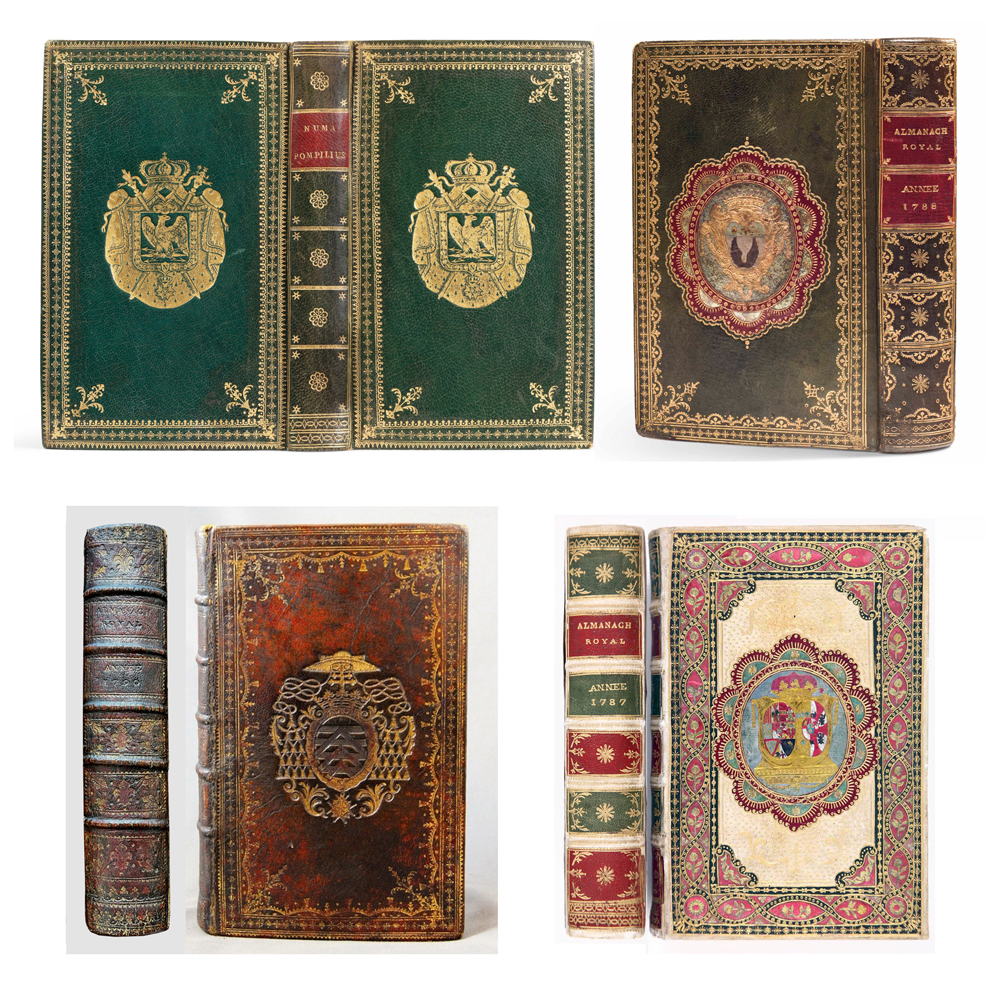
| In Comparative Diagram 4, we see 4 quite different Delorme examples, all have been decorated with the del-r-xox roulette, these bindings range in date from 1786 to 1790. Three of these bindings are Almanach Royals, I cannot over stress the importance of the Almanachs, these bindings unlike most others give us a relatively certain fix on the date of their manufacture. For this reason the Almanach bindings of Dubuisson and Delorme serve as a backbone to understanding the ever changing dentelle and mosaic fashions and their chronologies in the mid to late 18th century. |
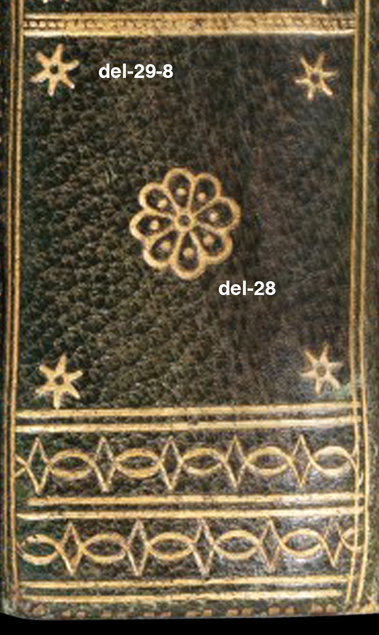
| In Comparative Diagram 5, we see an enlargement of the lower spine that has been divided into panels with double fillets and fillets imbedded with dots where there would usually be a raised band. In the corners of the panels we find stars with six points and a hollow circular center (del-29-8), while the centers of the panels are decorated with a simple 8 lobed fleuron with an open center and dots in each of the lobes (del-28). In the lower panels we see a pallet similar to those catalogued by Barber as PAL 48 and PAL 49 (see Comparative Diagram 6). Barber's examples differ from this Delorme example in size and shape however there is an undeniable affinity in these tools. On the next page were are going to examine another signed Delorme binding from 1786 where see see this same pallet. |
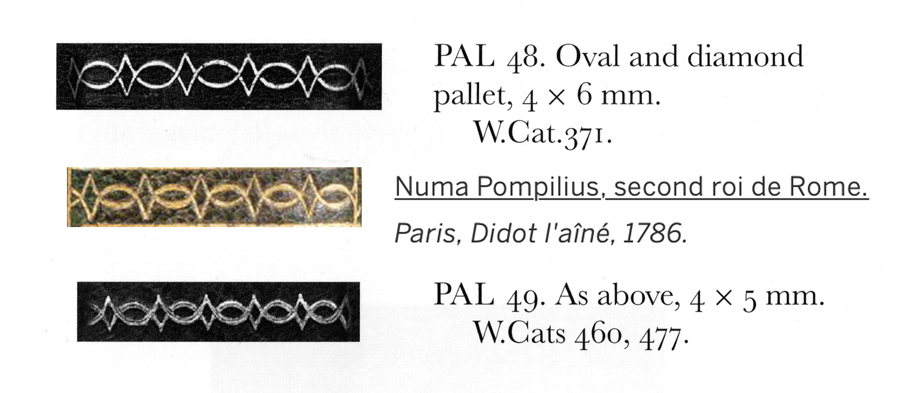
|
click here to return to the HOME page. click here to see an INDEX of the 2017 pages. see below links to previous work |
| Even experts are sometimes wrong, before you spend thousands on a book, please do your own research! Just because I say a certain binding can be attributed to le Maitre isn't any kind of guarantee, don't take my word for it, go a step further and get your own proof. In these pages I have provided you with a way of doing just that. |
| Virtual Bookings, created by L. A. Miller | return to the Home page of VIRTUAL BOOKBINDINGS |